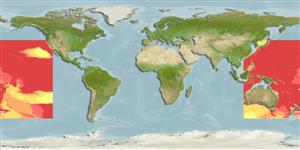Teleostei (teleosts) >
Myctophiformes (Lanternfishes) >
Myctophidae (Lanternfishes) > Myctophinae
Etymology: Myctophum: Greek, mykter, -eros = nose + Greek, ophis = serpent (Ref. 45335).
More on author: Garman.
Environment: milieu / climate zone / depth range / distribution range
Ecology
Marine; bathypelagic; oceanodromous (Ref. 51243); depth range 412 - 1537 m (Ref. 27311). Deep-water; 42°N - 52°S, 112°E - 117°W
Circumglobal (Ref. 7300) in all tropical and subtropical waters (Ref. 47377). Eastern Atlantic: Morocco to South Africa (as expatriates in Agulhas water pockets). Western Atlantic: between about 42°N and 34°S. Indian Ocean: between 7°N and 24°S. Pacific Ocean: between 32°N and 31°S, but extends northward to 40°N in the Kuroshio Current. South China Sea (Ref.74511).
Length at first maturity / Size / Weight / Age
Maturity: Lm ?, range 6 - ? cm
Max length : 8.3 cm SL male/unsexed; (Ref. 4479)
Dorsal spines (total): 0; Dorsal soft rays (total): 12 - 14; Anal spines: 0; Anal soft rays: 18 - 21; Vertebrae: 36 - 39. Branchiostegal rays: 9-10 (Ref. 31442). Anal organs 14; male supracaudal gland has 5-8, female infracaudal gland with 2-6 small, round to oblong spots, respectively; may be distinguished from all other Myctophum possessing cycloid scales by its angulate, non-serrate, posterodorsal margin of the operculum (Ref. 39633).
High-oceanic, nyctoepipelagic at the surface and to 950 m and generally found between 475-850 m during the day (Ref. 4479). Neustonic to mesopelagic (Ref. 58302). Oviparous, with planktonic eggs and larvae (Ref. 31442). Lipid content is 3.8 % in fresh body weight and wax ester is 10.6 % in total lipids (Ref. 9193). Females reach sexual maturity at 4.8 cm, males at 3.5 cm (Ref. 47377).
Hulley, P.A., 1990. Myctophidae. p. 398-467. In J.C. Quero, J.C. Hureau, C. Karrer, A. Post and L. Saldanha (eds.) Check-list of the fishes of the eastern tropical Atlantic (CLOFETA). JNICT, Lisbon; SEI; Paris; and UNESCO, Paris. Vol. 1. (Ref. 4479)
IUCN Red List Status (Ref. 130435: Version 2024-2)
Threat to humans
Harmless
Human uses
Tools
Special reports
Download XML
Internet sources
Estimates based on models
Preferred temperature (Ref.
123201): 4.2 - 8.7, mean 6.2 °C (based on 536 cells).
Phylogenetic diversity index (Ref.
82804): PD
50 = 0.5000 [Uniqueness, from 0.5 = low to 2.0 = high].
Bayesian length-weight: a=0.00912 (0.00478 - 0.01739), b=3.10 (2.93 - 3.27), in cm total length, based on LWR estimates for this species & (Sub)family-body (Ref.
93245).
Trophic level (Ref.
69278): 3.4 ±0.45 se; based on food items.
Generation time: 2.6 ( na - na) years. Estimated as median ln(3)/K based on 1
growth studies.
Resilience (Ref.
120179): Medium, minimum population doubling time 1.4 - 4.4 years (K=0.42; tm=3).
Fishing Vulnerability (Ref.
59153): Low to moderate vulnerability (28 of 100).
